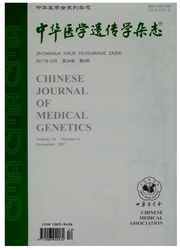

 中文摘要:
中文摘要:
目的对1个F8基因新发双突变家系进行基因诊断及产前诊断。方法用PCR-测序技术检测该家系先证者F8基因全外显子突变情况,同时检测100名正常人F8基因在患者突变位点的碱基序列以排除多态性。联合短串联重复序列基因连锁分析对家系中的女性进行携带者筛查,并为其提供产前诊断。结果PCR-测序结果显示先证者F8基因第1外显子第171位(C.1)存在A〉T突变,使蛋氨酸密码子(起始密码子ATG)突变为亮氨酸密码子(TTG),第174位(C.4)存在C〉T突变,使谷氨酰胺密码子CAA突变为终止密码子TAA。100名正常人此两位点未见此种突变,先证者母亲及其妹妹此两位点为杂合突变。羊水标本SRY阳性,F8基因第1外显子第171位(C.1)及174位(c.4)未见突变,且连锁分析显示胎儿遗传了外祖父来源的X染色体。结论明确了该家系的F8基因致病性突变,并指导了携带者女性进行产前诊断,同时报道了F8基因两个新发突变。
 英文摘要:
英文摘要:
Objective To conduct genetic diagnosis for a family affected with hamophilia A. Methods Potential mutations of the F8 gene were analyzed with PCR and Sanger sequencing. Carriers of the mutation were identified through linkage analysis using short tandem repeat (STR) markers. Suspected mutations were verified among 100 healthy controls to rule out genetic polymorphism. Prenatal diagnosis was provided based on the above results. Results Sequencing analysis has identified two mutations, c. 1 A〉T and c. 4 C〉T, which have replaced the start codon (ATG) with leucine (TTG) and glutamine (GAA) with the stop codon (TAA), respectively. The same mutations were not found among the 100 healthy controls. The patient's mother and sister were heterozygous for the same mutations. Upon prenatal diagnosis, the fetus was determined as a male and did not harbor the above mutations. Linkage analysis also confirmed that the fetus has inherited the non-risk X chromosome from his maternal grandfather. Conclusion Detection of pathogenic mutations can enable prenatal diagnosis for the disease.
 同期刊论文项目
同期刊论文项目
 同项目期刊论文
同项目期刊论文
 期刊信息
期刊信息
